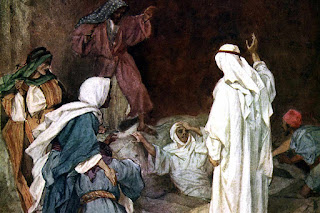LENT IS A TIME OF RISING FROM WHERE WE LAY
Fr. Ugochukwu
Ugwoke, ISch
Homily for the Fifth
Sunday in Ordinary Time, Year A
Scriptural Texts: Ezekiel
37:12:14, Romans 8:8-11, John 11:1-45
On
this fifth Sunday in Lent, our Lenten journey with Jesus takes us to a strange
location, the tomb. This is seen in the story of the raising of Lazarus from
the dead (John 11:1-42). Generally, the tomb is the resting place of the dead.
It is a symbol of death and the end of life. But in Christianity, especially
with the death and resurrection of Jesus, our understanding of the tomb has
taken up a new meaning. The tomb has come to represent for us, the ultimate
triumph over death and the promise of eternal life. So, when Jesus takes us to
the tomb on this fifth Sunday of Lent,
it is to prove to us his power over death and to assure us the pledge of life
eternal.
In
the Bible, we find three instances where Jesus raised the dead to life. First is
the raising of the daughter of Jairus (Mark 5:22-23). The second is the raising
of the son of the widow of Nain (Luke 7:11-17), and the third is the raising of
Lazarus (John 11:1-45). Amongst these three miracles, the raising of Lazarus is
unique because at the point of the miracle, Lazarus had been dead and buried for
four days, and would already be smelling (John 11:39). However, despite this
condition, Jesus was still able to raise him back to life in order to teach us
that no matter how foul and festering our situation is, he is able to turn it
around. No matter how deep our despair or how long we have been dead in sin,
Jesus can restore us to life. It does not matter how long you have borne your
troubles. No stone is too heavy for Jesus to roll away.
From
today’s gospel passage, we understand that Jesus and Lazarus were friends but
then, Jesus did not raise Lazarus from the dead solely on account of their friendship. Jesus
raised Lazarus from the dead because of the faith of the sisters of Lazarus in
the resurrection of the dead (John 11:21-27). What this tells us is that faith
in Jesus can overcome death and other afflictions of life. Whenever we find
ourselves in Bethany (a house of grief and affliction), let us always remember
that God is our help as the name of Lazarus depicts, and our faith in Jesus can
bring us the restoration and transformation that we need.
When
Jesus got to the place, the gospel passage tells us that he was deeply moved by
the grief of Lazarus’ sisters, Mary and Martha, and the other mourners. As a
concrete expression of his empathy and compassion, Jesus wept with them and
shared in their sorrow (John 11:35). The lesson we learn from this is that Jesus
shares in our plight. He weeps with us when we are mourning and he rejoices with
us when we are celebrating. He teaches us to do the same for others. Let us
learn to show compassion and empathy to others especially those in need.
Today,
Jesus is calling out to us in the same way as he called Lazarus to come out
(John 11:43). However, this time around, he is not calling us to come out of
the tombs of death but from the tombs of sin, spiritual stagnation, darkness, unforgiveness,
self-centeredness, hatred, anger, sexual immorality, jealousy and what have
you. A tomb is anything that separates us from the source of light, Jesus
himself. As such, the Lenten season is a time of rising from our different
tombs where we lay. It is a time unbinding ourselves from every chain and
bondage of addictions and bad habits. Unbind yourself and unbind those you are
holding captive. We pray that this season of Lent may be a time of renewal for
us. May we turn to Jesus, who is the resurrection and the life, and may we be
transformed by his love and mercy. And may the hope and new life of the resurrection
fill us with joy and peace. Amen.



Amen. God bless you Fr. Ugochukwu
ReplyDelete